Yew Tree (Taxus Yew Tree) Profile
Written by Iris
Nov 13 2021
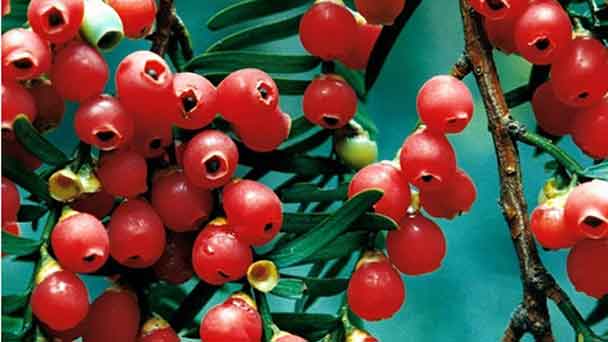
The yew tree is a coniferous evergreen related to such plants as pine, spruce, fir, cedar and cypress. This slow-growing tree grows larger over time, and while most trees may be 10 to 15 feet tall, this long-lived tree can grow to 60 feet or more in time, growing a huge trunk. The bark is red and flaked irregularly. The needle-like leaves are dark green, ½ to 1½ inches long and no more than an eighth of an inch wide. It has soft leaves and a shiny upper surface.
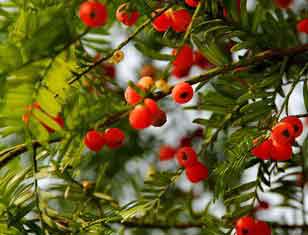
Read More:
12 Wonderful Evergreen Shrubs for Your Garden
Get a loose, damp, but not wet soil medium such as sterile potting soil or peat moss and mix with the seeds you want to sprout. Two cups of medium should be fine for all but a huge amount of seeds.
Put the seeds and medium in a large enough zip-lock type freezer bag that will hold the two cups of medium. Seal the bag and poke 3 or 4 pencil lead sized holes in the bag and write the date on the bag.
Put this in a spot out of direct or strong light for 6 months at room temperature - as close to 20 Celsius or 68 Fahrenheit as possible.
Next, put the bag in your fridge (not freezer) for 10 months. Take a look occasionally starting after 6 months to see if any of the seeds have rooted. If so, take the seed out and put in a 10 cm (4 inch) pot of its own with a mix of compost and sand. Bury the seed about 1 cm (3/8 inch) deep, and be careful not to break the root. Put in a bright, non-direct sun spot and keep the soil moist.
After 10 months, plant all the seeds as above.
If after the first year some of the seeds don't sprout, leave them outside in a shady area, keep moist and leave until they sprout - winter and summer. It can take years for all of them to sprout.
First, get 10 cm (4 inch) pots and 3/4 fill with compost and sand for the soil mix.
Take cuttings of 10-15 cm (4-6 inches) long new growth (green twig), and pull off all the leaves of about half of it on the lower end of each one.
Make a hole in the soil with your finger or a pencil in each pot, and put the lower end of the cutting in the soil, so that half is above the soil, half in the soil.
Gently firm the soil around the cutting to make full contact with the soil, but don't pack it down hard.
Water, and put in good light, but not direct sun. Keep the soil moist.
Cuttings root easily, and most should take without issue. Don't let the cutting in the pot get frost.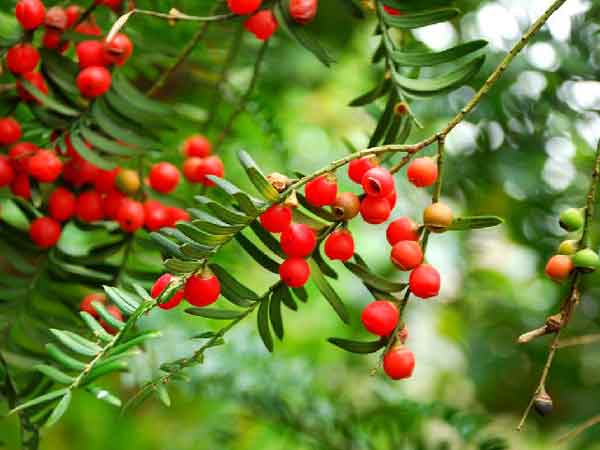
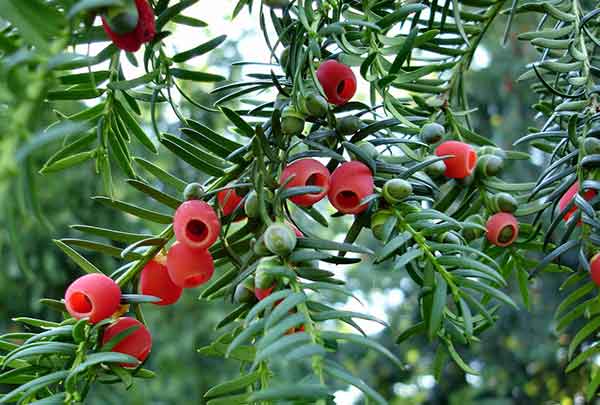
Yews are among the finest evergreens for landscaping uses. In addition to the wild kinds, there are numerous garden varieties and hybrids which show great variation in height, habit of growth and other important characteristics and this makes it possible for the planter to select from among them those that suit his purposes best.
Yews, allowed to grow without clipping or shearing, develop into magnificent specimen plants, but they stand pruning well and are among the finest of all evergreens for planting as formal hedges and for topiary work. (See Topiary Work.) The prostrate and spreading kinds are effective ground covers.
Yews may be transplanted without undue difficulty even when quite large. Should they outgrow their allotted space, they may be pruned back severely and will “break” (put forth new shoots) even from thick old branches that have been cut back. In this respect they differ from many other evergreens.
Taxus baccata ‘Repandens’
Spreading English Yew, height can be anywhere from 4 – 8 feet and wide sprawling and can grow 10 – 15 feet in width. Can be quite draught tolerant once established, great in forest planting or where a wide sprawling hedge is required. H: 4-8 ft / 10-15 yrs W: 10-15 ft / 10-15 yrs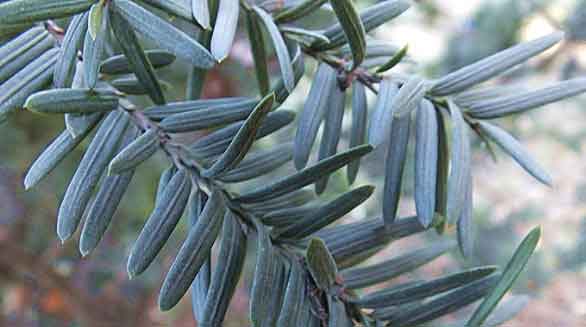
In addition, pests that infest yews in particular do not exist. However, lice occasionally appear in the yew hedges, especially if lice infested plants in the immediate surrounding and then continue to spread on the yew. Mostly it is going about the brown scale that can get to the yew due to strong winds.
The brown scale is recognisable due to round brown surface, which is equipped with white dots. Primarily the brown scale takes roots in colonies at the plant stem and the leaves. They excrete honeydew which, in turn, results in a clogging of the leaves and these cannot absorb oxygen or light. Consequently, they die after the brown colouring of the leaves.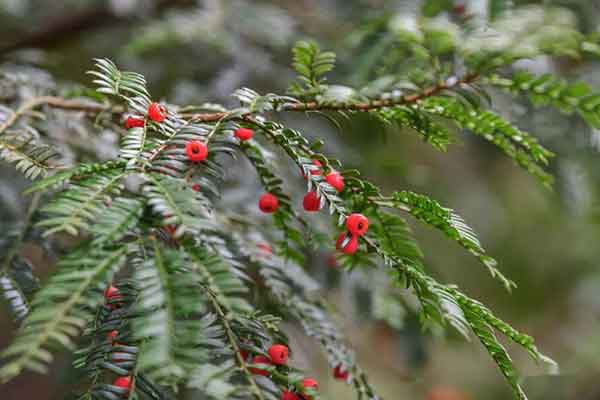
At the other extreme, Yew Trees respond wonderfully to trimming, and the more they are clipped, the denser they become. For hedges – short and tall – they are ideal, growing into solid walls of green that can be clipped into rounded or straight forms very easily. Because they grow so well in both sun and shade, a hedge will look uniform and beautiful even if it passes in and out of the light crossing your garden – very few other plants can do this.
It is in shade that Yew Trees have the greatest value. Every garden has shady areas, and as trees mature the shade tends to increase. Most evergreens need lots of sun, but Yew Trees thrive in partial shade, and even in light full shade, such as on the north side of fences, walls and buildings, or beneath deciduous trees. Clipped or un-clipped, they find a natural home in these areas, and solve your shade problems instantly.
Let's not forget planters and boxes, where Yew Trees are also perfect, because their size can be so easily controlled, and they can be trimmed into many forms that compliment the rest of your garden. In fact, even if you only have a terrace or balcony, Yew Trees give instant maturity to those spaces, and a stable feel to spaces that are often only filled with temporary annual flowers.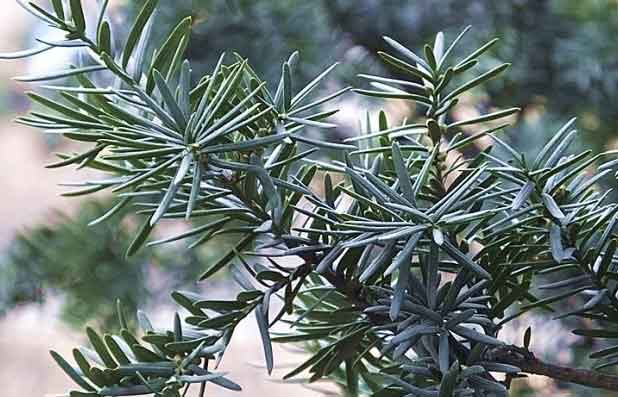
Yew Tree (Taxus Yew Tree) PictureYew Tree (Taxus Yew Tree) InfoYew Tree (Taxus Yew Tree) Distribution AreaHow to Grow and Care for Yew Tree (Taxus Yew Tree)How to Grow Yew Tree (Taxus Yew Tree)How to Care for Yew Tree (Taxus Yew Tree)Uses of Yew Tree (Taxus Yew Tree)Varieties of Yew Tree (Taxus Yew Tree)Melford YewHicks YewIrish Golden YewTaxus X Media Hm EddieFlushing Parade YewHillii YewYew Tree (Taxus Yew Tree) Common Pests/DiseasesRoot rotBrown scaleYew Tree (Taxus Yew Tree) Design TipsYew Tree (Taxus Yew Tree) Companion Plants
Yew Tree (Taxus Yew Tree) Picture

Yew Tree (Taxus Yew Tree) Info
| Botanical Name | Taxus spp. |
| Common Names | Yew bush, yew tree, yew shrub |
| Plant Type | Perennial |
| Mature Size | 4–60 ft. tall, 4–20 ft. wide (depends on variety) |
| Sun Exposure | Full, partial, shade |
| Soil Type | Loamy, moist, well-drained |
| Soil pH | Neutral |
| Bloom Time | Nonflowering |
Yew Tree (Taxus Yew Tree) Distribution Area
Yew Tree's latitudinal distribution encloses 63°N-30°N. Yew Tree is native to most of Europe, northern Africa (the Atlas Mountains), Asia Minor, the Caucasus and northern Iran. Yew is most commonly found growing in southern England. Yew Tree's leaves are straight with small needles. Each seed is enclosed in a red berry-like structure known as an aril.Read More:
12 Wonderful Evergreen Shrubs for Your Garden
How to Grow and Care for Yew Tree (Taxus Yew Tree)
How to Grow Yew Tree (Taxus Yew Tree)
- With Seeds
Get a loose, damp, but not wet soil medium such as sterile potting soil or peat moss and mix with the seeds you want to sprout. Two cups of medium should be fine for all but a huge amount of seeds.
Put the seeds and medium in a large enough zip-lock type freezer bag that will hold the two cups of medium. Seal the bag and poke 3 or 4 pencil lead sized holes in the bag and write the date on the bag.
Put this in a spot out of direct or strong light for 6 months at room temperature - as close to 20 Celsius or 68 Fahrenheit as possible.
Next, put the bag in your fridge (not freezer) for 10 months. Take a look occasionally starting after 6 months to see if any of the seeds have rooted. If so, take the seed out and put in a 10 cm (4 inch) pot of its own with a mix of compost and sand. Bury the seed about 1 cm (3/8 inch) deep, and be careful not to break the root. Put in a bright, non-direct sun spot and keep the soil moist.
After 10 months, plant all the seeds as above.
If after the first year some of the seeds don't sprout, leave them outside in a shady area, keep moist and leave until they sprout - winter and summer. It can take years for all of them to sprout.
- With Cuttings
First, get 10 cm (4 inch) pots and 3/4 fill with compost and sand for the soil mix.
Take cuttings of 10-15 cm (4-6 inches) long new growth (green twig), and pull off all the leaves of about half of it on the lower end of each one.
Make a hole in the soil with your finger or a pencil in each pot, and put the lower end of the cutting in the soil, so that half is above the soil, half in the soil.
Gently firm the soil around the cutting to make full contact with the soil, but don't pack it down hard.
Water, and put in good light, but not direct sun. Keep the soil moist.
Cuttings root easily, and most should take without issue. Don't let the cutting in the pot get frost.

How to Care for Yew Tree (Taxus Yew Tree)
- Light
- Soil
- Water
- Temperature and Humidity
- Fertilizer
- Pruning

Uses of Yew Tree (Taxus Yew Tree)
Landscaping UsesYews are among the finest evergreens for landscaping uses. In addition to the wild kinds, there are numerous garden varieties and hybrids which show great variation in height, habit of growth and other important characteristics and this makes it possible for the planter to select from among them those that suit his purposes best.
Yews, allowed to grow without clipping or shearing, develop into magnificent specimen plants, but they stand pruning well and are among the finest of all evergreens for planting as formal hedges and for topiary work. (See Topiary Work.) The prostrate and spreading kinds are effective ground covers.
Yews may be transplanted without undue difficulty even when quite large. Should they outgrow their allotted space, they may be pruned back severely and will “break” (put forth new shoots) even from thick old branches that have been cut back. In this respect they differ from many other evergreens.
Varieties of Yew Tree (Taxus Yew Tree)
Melford Yew
This very narrow, upright yew is deepest green. It is an ideal hedging plant, border specimen for small gardens, great in shady areas, too. Can be grown in containers. Great for formal design. H: 3-6 ft in 10 years W: 1 ft in 10 yrs Soil: Average Zone: 5Hicks Yew
A narrow columnar to conical Yew with upright branches bearing dark glossy green foliage. Red berries. Great for formal hedges. Does well in sun or shade. Prune to shape. H: 8-12 ft W: 3-4ft Soil Well Drained Zone 4B - 7AIrish Golden Yew
Upright growing evergreen with green needles that are eddged in golden yellow. Versatile and sought after for formal gardens. Great in planters. Very slow growing. Also known as Taxus baccata stricta aurea. H: 4-6 ft / 10 yrs W: 1ft / 10 yrs Soil: Average Zone: 5Taxus X Media Hm Eddie
Provides instant privacy hedging. Can handle full shade to light sun. H: 18-20 ft /20yrs W: 3.5 ft / 20 yrsTaxus baccata ‘Repandens’
Spreading English Yew, height can be anywhere from 4 – 8 feet and wide sprawling and can grow 10 – 15 feet in width. Can be quite draught tolerant once established, great in forest planting or where a wide sprawling hedge is required. H: 4-8 ft / 10-15 yrs W: 10-15 ft / 10-15 yrs
Flushing Parade Yew
Upright, very narrow growth habit, dark green needles, and slower growth rate make this yew unique. If used in urban areas or designs that require this growth habit. Berries can be produced but are not common. Plant as speciment or narrow hedging option. Growths 6-12 inches per year. Prune to encourage fullness. H: 5-10 ft W: 1-2 Ft Soil: Moist, Well-Drained Zone: 5Hillii Yew
This broad, compact pyramid is deepest green with a very tidy, uniform habit. Use in sun or shade for a gorgeous hedge or foundation plant. Yews are also great container plants! H: 6-8 ft, W: 2-3 ft / 10 yrs Soil, Well-Drained Zone: 5
Yew Tree (Taxus Yew Tree) Common Pests/Diseases
The yew hedge does not rank among the robust and insensitive plants. Species-specific diseases do not exist. Predominantly a wet keeping leads to diseases.Root rot
If waterlogging has been developed by too much moisture, the yew mostly reacts instantly with root rot. You can plan out small yews and let the root bale dry for approximately two days. Cut the rotten parts of the root and subsequently replant the yew in fresh and dry soil. Usually the yew recovers again.In addition, pests that infest yews in particular do not exist. However, lice occasionally appear in the yew hedges, especially if lice infested plants in the immediate surrounding and then continue to spread on the yew. Mostly it is going about the brown scale that can get to the yew due to strong winds.
Brown scale
The brown scale is predominantly domestic in big cities and is named after its shield that resembles a scale. This ensures that even chemical insecticides cannot harm it in most cases. With alcohol, the shell can be softened so that insecticides can have a stronger effect.The brown scale is recognisable due to round brown surface, which is equipped with white dots. Primarily the brown scale takes roots in colonies at the plant stem and the leaves. They excrete honeydew which, in turn, results in a clogging of the leaves and these cannot absorb oxygen or light. Consequently, they die after the brown colouring of the leaves.

Yew Tree (Taxus Yew Tree) Design Tips
Yew Trees have many uses in the garden. Although not seen so often, the most basic one is to simply let them grow naturally, the way their natures intended them. Some forms will grow into upright columns of rich green, while others will spread wide, into broad bushes with irregular outlines. Although not often done, this is a terrific way to grow Yew Trees in more natural garden styles, without the need for regular clipping. These trees will naturally grow denser as they mature, and turn into wonderful specimens – just plant them and leave them to grow, what could be easier?At the other extreme, Yew Trees respond wonderfully to trimming, and the more they are clipped, the denser they become. For hedges – short and tall – they are ideal, growing into solid walls of green that can be clipped into rounded or straight forms very easily. Because they grow so well in both sun and shade, a hedge will look uniform and beautiful even if it passes in and out of the light crossing your garden – very few other plants can do this.
It is in shade that Yew Trees have the greatest value. Every garden has shady areas, and as trees mature the shade tends to increase. Most evergreens need lots of sun, but Yew Trees thrive in partial shade, and even in light full shade, such as on the north side of fences, walls and buildings, or beneath deciduous trees. Clipped or un-clipped, they find a natural home in these areas, and solve your shade problems instantly.
Let's not forget planters and boxes, where Yew Trees are also perfect, because their size can be so easily controlled, and they can be trimmed into many forms that compliment the rest of your garden. In fact, even if you only have a terrace or balcony, Yew Trees give instant maturity to those spaces, and a stable feel to spaces that are often only filled with temporary annual flowers.

Yew Tree (Taxus Yew Tree) Companion Plants
Good companion plants for yews include roses (Rosa spp.), irises (Iris spp.), lilacs (Syringa spp.), viburnums (Viburnum spp.), hydrangeas (Hydrangea spp.) and plants of Mediterranean origin, such as rosemary (Rosmarinus spp.) and lavender (Lavandula spp.).Latest Updated
- Benefits of Bugleweed - 7 Science-backed Health Benefits
- Bugleweed Dangers & Side Effects - Is It Poisonous?
- How to Plant Evergreen Trees - What You Should Know
- When to Plant Evergreens - Grow Guide for Evergreen Trees
- 12 Wonderful Evergreen Shrubs for Your Garden
- 12 Popular Evergreen Plants with Pictures for Beginners
- When And How To Prune A Lilac Bush Like a Pro
- How to Grow & Care for Lilac Vine (Hardenbergia Violacea)
- Japanese Lilac Tree (Syringa Reticulata) Care & Propagation Guide
- Shumard Oak Pros and Cons - What to Know
Popular Articles
- Winter maintenance of Antirrhinum Majus
- How to Grow Terminalia Mantaly Tree
- How to Grow and Care for Crossostephium Chinense
- How to grow Antirrhinum Majus in spring
- Peristeria Elata (Dove Orchid) Profile: Info & Care Guide
- Underwatered Snake Plant (Sansevieria Trifasciata) - Signs And How To Fix
- How to Care for Brazilian Jasmine Plant (Mandevilla Sanderi)
- How to Grow & Care for Graptopetalum Purple Delight in Summer
- Rosa Chinensis (China Rose): Plant Growing & Care Tips
- How to Care for Baby Sun Rose (Aptenia Cordifolia)